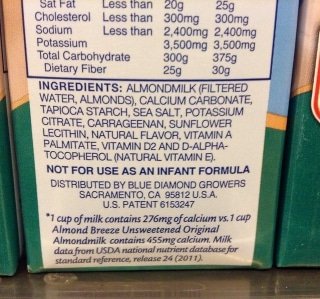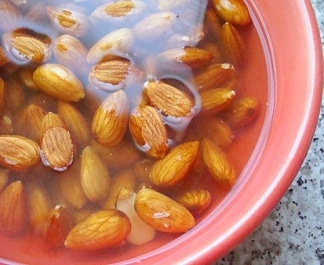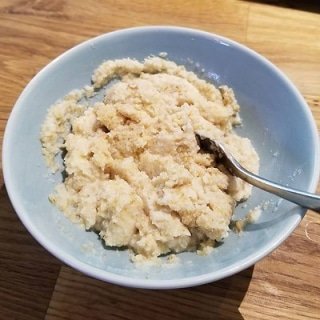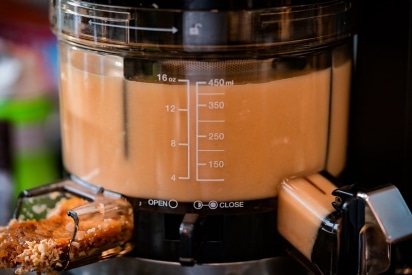Why buy almond milk from the store when you can make a healthier version easily at home if you have a juicer? Here is what you need to know about how to make almond milk in a juicer.
Milk is loved by many. It is something many grow up drinking. However, dairy milk is not easy to digest and for lactose-intolerant people, it is downright unhealthy. Finding a better substitute for that sure sounds intriguing. Thus, you have almond milk.
Nut milk, especially almond milk, has seen a rise in popularity over the past years. Spearheaded by health-conscious individuals, the popularity of nut milk is attributed to the generally low-calorie and lactose-free substitute of traditional dairy milk.
Also, people who are cleansing need an option with some protein. Almond milk helps fill that gap in their diet that most other dairy alternatives don’t.
Apart from health reasons, almond milk is also better for the environment. Growing almond trees and then extracting milk from almonds produces fewer greenhouse gas emissions than rearing cattle for dairy milk.
Table of Contents
Store-bought Vs. Home Made
 Let us be honest; buying almond milk from the store sure is convenient. You do not need to prep anything; no cleanup is required, and it takes little time. You can simply add almond milk to your list of groceries every week, and you are done.
Let us be honest; buying almond milk from the store sure is convenient. You do not need to prep anything; no cleanup is required, and it takes little time. You can simply add almond milk to your list of groceries every week, and you are done.
But there is something you should know. Store-bought almond milk is not always the healthiest option. They often contain preservatives and generally do not have as many health benefits as homemade almond milk.
If you choose to go the homemade route, you can enjoy fresh almond milk without having to worry about that.
Can you Make Almond Milk with a Juicer?
The short answer to that question is yes. Making your own almond milk with a slow juicer is actually easier than you think. It is even easier than using a blender where you’ll need to use a nut milk bag or cheesecloth to manually strain the pulp out of the milk.
Keep in mind that only masticating juicers, as opposed to centrifugal ones will be able to do the job. This is because a slow juicer’s augur can crush hard ingredients slowly to more easily separate the juice from the pulp. A centrifugal juicer’s blades will make a more mushy drink, as the filter screen won’t be enough to strain out the smaller solid particles.
When you add water and almonds to a slow juicer the augur slowly crushes them and squeezes out the milk through the special filter screen leaving fairly dry pulp to be ejected from a different outlet. The no strain nut milk is ready before you know it!
How to Make Cold-pressed Nut Milk
Masticating juicers that make nut milk come with an additional pulp extractor screen that makes smooth milk. The liquid extracted will be free of any solid particles and the leftover dry meal is ejected through a separate channel.
Follow this homemade almond milk recipe to make some with a slow juicer:
 Whether you’re using a juicer or not to make almond milk, you should follow this step anyway. Start with 170 – 200 grams of almonds. The almonds should be unroasted and unsalted. Put them in a small bowl and pour cold water in. The idea here is to let the almonds soak in the water. You can even use some lemon juice. Let the almonds soak for at least 8 to 10 hours. This first step helps the almonds get softer and the skins to loosen, which makes it much easier for your juicer to do its job without straining the motor.
Whether you’re using a juicer or not to make almond milk, you should follow this step anyway. Start with 170 – 200 grams of almonds. The almonds should be unroasted and unsalted. Put them in a small bowl and pour cold water in. The idea here is to let the almonds soak in the water. You can even use some lemon juice. Let the almonds soak for at least 8 to 10 hours. This first step helps the almonds get softer and the skins to loosen, which makes it much easier for your juicer to do its job without straining the motor.
When you have soaked the nuts for a while, take the almonds out and rinse thoroughly. You will see the water comes out slightly hazy and a little brown. Rinse and repeat till the water runs clear.
Take the nuts and put them in a fresh bowl of water. A thing to note here, the more water you put in the juicer, the lighter the milk will be. Preferably, we suggest that you don’t add too much water in the beginning as you can add more water as you see fit when the juicer is running. The almond to water ratio should be around 1:2 to start with.
 Turn on the juicer and carefully start spooning a ladle full of almonds and water in the juicer. Ideally, it would be best if you went at a steady pace here. Do not go too quickly, or you run the risk of damaging your juicer. The augur needs time to crush and extract milk from the almonds, which will be released into your pitcher or bottle. Keep adding more almonds and water. Add more water if you think the milk released is too thick. But as we mentioned, you do not want almond milk that is too light.
Turn on the juicer and carefully start spooning a ladle full of almonds and water in the juicer. Ideally, it would be best if you went at a steady pace here. Do not go too quickly, or you run the risk of damaging your juicer. The augur needs time to crush and extract milk from the almonds, which will be released into your pitcher or bottle. Keep adding more almonds and water. Add more water if you think the milk released is too thick. But as we mentioned, you do not want almond milk that is too light.
You may prefer to flavor your almond milk but this is a personal preference. You can add ingredients like honey or cocoa powder when you are done making the milk. You can also add fruits like berries while blending, as a masticating juicer can do a great job juicing them by removing the seeds.
Almonds Soaked in Lemon Juice
If you’ve always eaten almonds as is, this might come off as quite new. However, there are some great benefits to soaking almonds in lemon juice or at least water that has a little lemon juice added to it.
Here are some benefits of soaking almonds:
This one is more of a personal preference. Raw almonds have tannins. This gives them a slightly bitter taste. Also, anyone who has had raw almonds before knows that they can be hard and crunchy. When you soak the almonds they get softer and get a boost in flavor. Some may prefer their almonds this way.
Nuts have inhibitors that act as protective agents that prevent the nuts from germinating until the conditions are ideal. When you ingest these, these inhibitors also prevent proper absorption of essential nutrients like calcium, copper, zinc, and magnesium. They also make digesting starches and sugars difficult. Soaking nuts in an acidic liquid activates the enzymes that neutralize the inhibitors, thereby making digestion and nutrient absorption easier.
Of course, if you are going to make almond milk, you will need to soak them to make it easier for the juicer and prevent the motor from being overly strained.
How to Store Homemade Almond Milk
When you are making a batch of almond milk, you can make some extra for you to enjoy later as well. One cup of almonds with 2 cups of water will give you roughly 2 cups of milk. Almond milk will stay fresh and drinkable for 2 to 3 days if you store it in the refrigerator. A glass mason jar or a clean glass pitcher is good.
What to do with Leftover Almond Meal
 If you are making almond milk at home, you will have almond meal leftovers. Please do not throw it away as that would be a complete waste! You can use it in a lot of creative ways:
If you are making almond milk at home, you will have almond meal leftovers. Please do not throw it away as that would be a complete waste! You can use it in a lot of creative ways:
References: Should You Soak Almonds Before Eating Them?
Images are all licensed under CC BY-SA 2.0: “Nutmilk in the Nama Juicer” by Tony Webster
“Home made Almond Milk” by AmazingAlmonds
“Homemade Almond Milk” by t-dubisme
“I made some weird hot cereal out of coconut flour, almond meal, and flax meal and it is Not Bad.” by izik
“Almond Milk” by JeepersMedia

